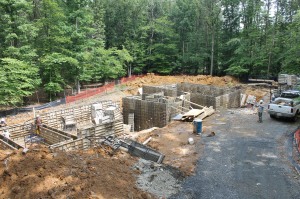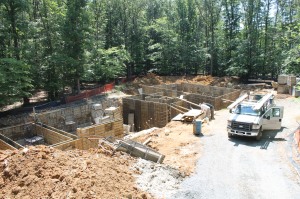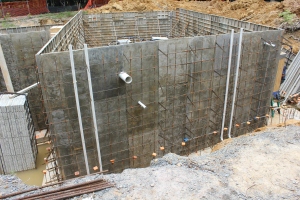Forming the interior of the wall helps our whole team get the wall penetrations correct. The typical penetrations (or wall sleeves) are needed for connections from one side of the wall to the other. The Plumbers, Electricians, and HVAC contractors are the usual suspects that need wall penetrations. In most cases when forming a foundation, Bartley can insert pieces of PVC as blockouts and then form both sides of the wall. With this concrete house, Bartley decided to give full access to the HVAC, Electrician and Plumbing contractors, which is why only the inside of the wall is formed. Although forming one side at a time takes a little longer, the other contractors can easily set their penetrations correctly which is important when working with a solid structure like concrete walls.
In concrete homes, electrical outlets (with conduits) are often placed inside the forms before pouring. This allowed the electrical wiring and outlets to be furnished within the wall which is smart when leaving the concrete interior walls as the finished product in lieu of drywall or another wall finish. This way the electrical outlet covers can be applied directly to the electrical outlet and rest against the concrete. If you look closely in some of the pictures you can see the blue electrical outlets that the electrician placed and drilled into the panels.
In the final two pictures, Bartley Corp is not onsite which allows the Plumber and Electrician to get their work done without interference. Once all the contractors, builder and architect say the penetrations are good, Bartley Corp will return to set the outside panel of the wall, insert the Thermomass insulation and place cast-in-place concrete walls.








